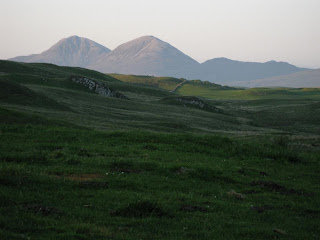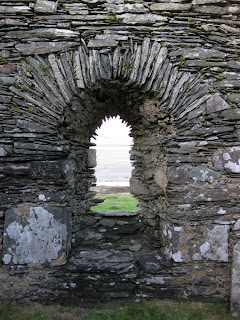[This is my entry written
3 June 2009.]
Today we woke up on time, but we still got a late start. I guess we thought that Laphroaig (la-froyg) was closer than it is. We booked ourselves in for a 10am tour this morning and it turned 10am when we were still about 3 miles away. Thinking that Laphroiag would be more formal than the others we'd visited so far (because it's more famous and more popular), we thought they probably would start right on time (the others started a few minutes late). So Robin phoned from the car and gave our coordinates as I was barreling down the road (and still waving to as many people as I could -- everyone waves on the road on Islay, not just when you're at a passing place; it's friendly island living). We were told they might be able to wait, but put our names on the list for 11:30 just in case. When we finally parked the car, since it's a big distillery, it still took us at least another minute and a half to make our way to the visitor centre. But they hadn't started yet. There were four other people on the tour: a young (early 30's?) American and two older men who sounded Irish to me.
Here are a couple views of the exterior of the distillery:


Our guide was David. He was visibly thrown-off by the scheduling change. I saw him ask who was probably the centre manager if he should modify the tour because we were starting late. She said no, just do what you usually do. I thought this was a little strange because David looked to be at least in his late 50s. Is he new at this? It turns out that, yes, he's been in the tour guiding job for about a year, but he's been at Laphroiag since the mid-70s. In the course of the tour he told us that he used to work in the warehouses (I think) but that handling all the barrels got to be too much on his body. He was even away from his job for more than a year to get his hip replaced. Having been at the distillery for so long (and having a very colourful personality) meant that he had a lot of good stories. In the old days workers on a break were able to drink samples from the still. He said it was better than Valium. As they do, the laws changed, and this is no longer allowed. David seemed to have fond memories of those days.
He also told us about the two visits Laphroaig has had from the Prince of Wales. The first visit, in the 80s was accompanied by 40 members of the press. During his visit last year, there was no press coverage at all. David was proud to tell us that Laphroiag is the only Islay distillery the Prince has ever visited.
I took several pictures at Laphroaig to document the whisky-making process. First, we were able to watch the wet barley get rolled out onto the malting floor:

Because it has been so warm in recent days the barley was germinating faster than usual as can be seen in this closeup of the barrel used to pour the barley on the floor:

A malting floor nearly completely covered with barley:

We were allowed to pick up and sniff the wet barley that had just been laid on the floor:

David showed us the kiln that burns the peat:

The barley is laid out on a mesh floor above the kiln. The heat dries the barley to stop its germination. The smoke from the peat fire infuses the barley and gives our Islay whiskies their distinctive flavour. Here we were able to look onto the drying floor. David said that the kiln had just been fired up a little bit ago. When it really gets going, you can't see the back wall anymore.

After the barley is dried (I think we call it malt now) it's put in the mash tuns and rinsed through a few times with hot waters of different temperatures. I didn't get a picture of the mash tuns. It's the liquid that is drained from the mash tuns that is used for distilling. The spent grain is fed to Islay's cattle (which are apparently very yummy to eat). Yeast is added to the liquid and fermentation begins. At this point, we are pretty much making beer. The fermentation is done in big vats called washbacks. Bowmore has wood washbacks. At Laphroiag (and also at Kilchoman) the washbacks are stainless steel. When the yeast is working hard there is a lot of bubbling activity. We tried to capture that here:

Here are a couple views of the washbacks:


The liquid at this stage in the process is called worts. It is pretty stinky and has a sharp though slightly sweet taste, with some carbonation from the fermentation with the yeast. Nevertheless, David broke out some little cups and gave us all a taste to try.


Once the worts has finished fermenting it moves on to the stills. This is where the magic happens. The spirit is distilled twice. Each distillery's stills are a different shape. This and the angle of the neck of the still (is it pointing up or down, is it parallel with the ground) are supposedly the key features that give a whisky its character.

As the spirit is produced it goes through a spirit safe. Here the distiller can test for alcohol content and flavour and decide when to take the "middle cut": the spirit that is put into casks. Here's David at the Laphroiag spririt safe:

When we reached the warehouse where the casks were filled I asked David if you can overfill a cask. I thought you would want to avoid losing a drop at all costs. This is where David told one of my favourite anecdotes (possibly better in the telling). He said, no, today the pump that fills the barrels will switch off automatically when it's finished (akin to a gas pump at a filling station is my understanding). But back in the day, he used to fill the casks and if you weren't paying attention ("if you were talking about the football or whatever") you could end up getting soaked with the stuff. Then you'd go home to your mum reeking so much that she'd accuse you of drinking at work. Here are some recently filled casks:

After the tour we tried both the Quarter Cask and the 12-year Festival bottling. (Islay's Music and Malt Festival, Feis Ile, occurred the week before we arrived and most distilleries did a special bottling for the event. We were initially planning to be on Islay the week of the festival, but when it became clear that accommodation was going to be hard to find, we opted for the week following. This turned out to be a good choice; staff at the distilleries were in good spirits (ha ha) because the festival was over and it had gone well and the masses of people who were thronging their visitor centres were now gone away so they were relaxed and happy.)
After our excellent tour from David we went down the road to the
Ardbeg Distillery (Ardbeg, Laphroaig, and Lagavulin are very close to each other on the southeastern coast of Islay). Ardbeg no longer malts their own barley (they get their malt from Port Ellen Maltings down the road) and they have converted their kiln rooms into the visitor centre shop and cafe. So we booked our spots for the 3pm tour and had a reasonably tasty lunch in their cafe.
After lunch, because we still had about an hour before the tour started (and of course we wouldn't want to be EARLY for our tour) we took a drive up the road to see Islay's one official Historic Scotland site: Kildalton Cross. It being another nice day (the heavy cloud forecast never materialised) we enjoyed the scenery:

I enjoyed finally getting to see the cross:


From the chapel nearby:

We got back to Ardbeg in plenty of time and had our tour done by Rachel, who announced at the very start that this was only her third tour so "be nice." She was very sweet but quite unsure of herself, even though she did a fine job and knew her stuff. Here's a picture of her consulting her notes at the spirit safe:

Ardbeg's mill (the malted barley is milled before it goes into the mash tuns):

The view of the distillery from the Ardbeg pier:

Unfortunately Ardbeg isn't nearly as tasty as Laphroaig; we made no purchases in their shop.
After Ardbeg I decided I wanted to back to the shop at Laphroiag and satisfy my vacation shopping impulse by buying their "Islay weather proof" jacket (very nice, with a nice Laphoiag stitched logo). David was manning the shop and seemed quite pleased to see us back. He offered us another wee dram and this time had the Cask Strength (very good, as fellow whisky-lovers may imagine). David was in a good mood. The weather was good and it had been a "good day." While sitting at the bar/counter sipping our dram he gave us each some chocolates that could no longer be sold in the shop since they "expired" on 1 June, and 5cl Quarter Cask mini-bottles. And pens! A Laphroaig pen for each of us. A wise choice indeed to return. [Two days later when I was wearing my jacket to protect me from some Islay weather, I found a piece of cat hair. How can I have cat hair on my new jacket? I'm thousands of miles from the cats. Further proof that, ah yes, they are always with me...]
It was a long day! And especially after 4 or 5 drams before 5pm, I was sleepy. When we got back to the cottage I had a wee lie down on the couch while Robin channel-surfed. At 9pm I was refreshed and ready for a walk. Today we decided to go left out of our road instead of right. I've been feeling a little lazy/guilty for doing only one walk on the walk map/guide I bought before the trip. I'd been thinking that if we drive out to a walk site we'd probably see better scenery and views than if we just walked locally. Ho hum. But after an already busy day I don't really feel like getting back in the car and doing all the single track shenanigans. I mean, I need to return the Fiat with the axles intact! So, we're walking along and arrived at a sign: "Footpath to Carnain." Hmmm, okay.

"Carn" generally denotes a hill, and yes, there was a hill in front of us, as well as lots of cows and sheep (we had also passed the sign for Knockdon Farm). These animals were very wary of us. They watched us closely and moved quickly if they thought we were getting too close.
The footpath soon ran out, but as we climbed we found that we were getting some of the most astounding views we have seen so far. We could see Bowmore on the left, and Port Charlotte and Bruichladdich on the right. As we climbed higher we could begin to see more and more of the complete southern coastline of the island.

And then, as we reached the top of the hill, the setting sun was the backdrop for the rocky hills of Islay to the north, Jura, Oronsay, and Colonsay. Shown here are the Paps of Jura:

All of this in our own backyard. It was an amazing find. I walked home elated.




















































